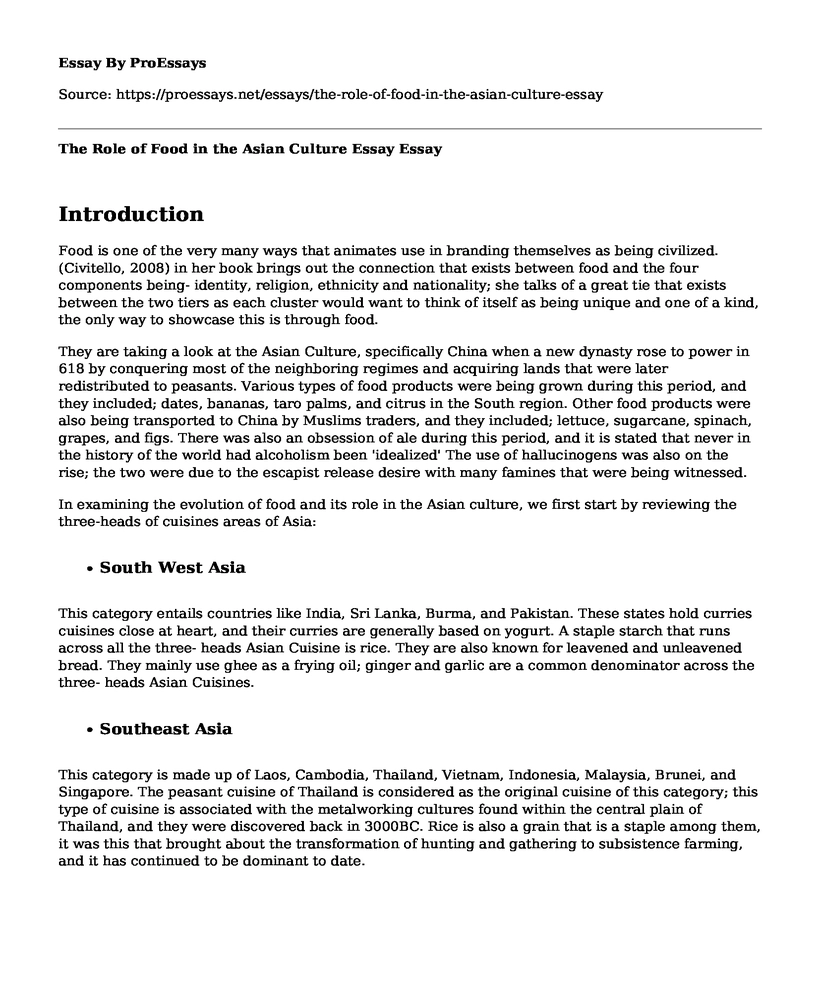Introduction
Food is one of the very many ways that animates use in branding themselves as being civilized. (Civitello, 2008) in her book brings out the connection that exists between food and the four components being- identity, religion, ethnicity and nationality; she talks of a great tie that exists between the two tiers as each cluster would want to think of itself as being unique and one of a kind, the only way to showcase this is through food.
They are taking a look at the Asian Culture, specifically China when a new dynasty rose to power in 618 by conquering most of the neighboring regimes and acquiring lands that were later redistributed to peasants. Various types of food products were being grown during this period, and they included; dates, bananas, taro palms, and citrus in the South region. Other food products were also being transported to China by Muslims traders, and they included; lettuce, sugarcane, spinach, grapes, and figs. There was also an obsession of ale during this period, and it is stated that never in the history of the world had alcoholism been 'idealized' The use of hallucinogens was also on the rise; the two were due to the escapist release desire with many famines that were being witnessed.
In examining the evolution of food and its role in the Asian culture, we first start by reviewing the three-heads of cuisines areas of Asia:
-
South West Asia
This category entails countries like India, Sri Lanka, Burma, and Pakistan. These states hold curries cuisines close at heart, and their curries are generally based on yogurt. A staple starch that runs across all the three- heads Asian Cuisine is rice. They are also known for leavened and unleavened bread. They mainly use ghee as a frying oil; ginger and garlic are a common denominator across the three- heads Asian Cuisines.
-
Southeast Asia
This category is made up of Laos, Cambodia, Thailand, Vietnam, Indonesia, Malaysia, Brunei, and Singapore. The peasant cuisine of Thailand is considered as the original cuisine of this category; this type of cuisine is associated with the metalworking cultures found within the central plain of Thailand, and they were discovered back in 3000BC. Rice is also a grain that is a staple among them, it was this that brought about the transformation of hunting and gathering to subsistence farming, and it has continued to be dominant to date.
-
North-East Asia
This category involves countries such as Korea, Japan, and China. Their cuisines include rice (being a staple grain) and egg noodles. They use vegetable oils in almost all of their food, unlike South West Asia that use ghee. They also use soy sauce in most of their dishes. China was since time immemorial, bountiful in terms of natural resources and food, this however not the case with Japan which had a large population with no adequate natural resources as it lay on broken lines of the volcanoes; it was an island. It is due to such factors that we see Japan acquiring most of China's food products including their culture and religion
The evolution of tea expressed between China, and Japan is also evident as the two countries took the practice very seriously with China closely equating it religion but this was not the case with Japan as it is only associated with the upper class in the society (Cwiertka, 2003) and to date is even prepared and offered inexpensive public places where people go to meet, bond and play games over tea. (Shannon, 1995)Conclusion
In conclusion, the evolution of food in Asian Culture played a very critical role in shaping their identity and setting each group apart from the other with their own individual and unique traits. For instance, Japan even adopted a symbol in their national flag in the form of a 'red ball' and referring to itself as being a land of the rising sun while also elevating the practice of taking tea to a commendable art.
References
Shannon, Christopher (1995). A World Made for Differences: Ruth Benedict's "The Chrysanthemum and the Sword" American Quarterly, 47, 659-680. Retrieved from https://www.jstor.org/stable/2713370
Cwiertka, Katarzyna (2003). Eating the World: Restaurant Culture in Early Twentieth-Century Japan. European Journal of East Asian Studies, 2, 89-116. Retrieved from https://www.jstor.org/stable/23615541
Civitello, Linda (2008). Cuisine and Culture: A History of Food and People. Hoboken, New Jersey: John Wiley & Sons, Inc. Retrieved from b-ok.cc/book/554546/935ef6
Cite this page
The Role of Food in the Asian Culture Essay. (2022, Mar 11). Retrieved from https://proessays.net/essays/the-role-of-food-in-the-asian-culture-essay
If you are the original author of this essay and no longer wish to have it published on the ProEssays website, please click below to request its removal:
- Research Paper on Incarceration
- Diversity and Health Assessments Essay Example
- Kid-Focused Marketing of Fast Food Increase the Risk of Obesity Essay
- Sexual Violence Against the Native American Women Essay
- Essay on Families of Pediatric Cancer Patients: Economic Impact of Losses, Disruptions, & Hardships
- Essay on Reaping Benefits of Disabled Worker Diversity: Tangible Benefits of Hiring Disabled Employees
- Age-Defining Plant-Based Cooking: Health-Enhancing Recipes for Soul-Inspired Eating - Essay Sample







